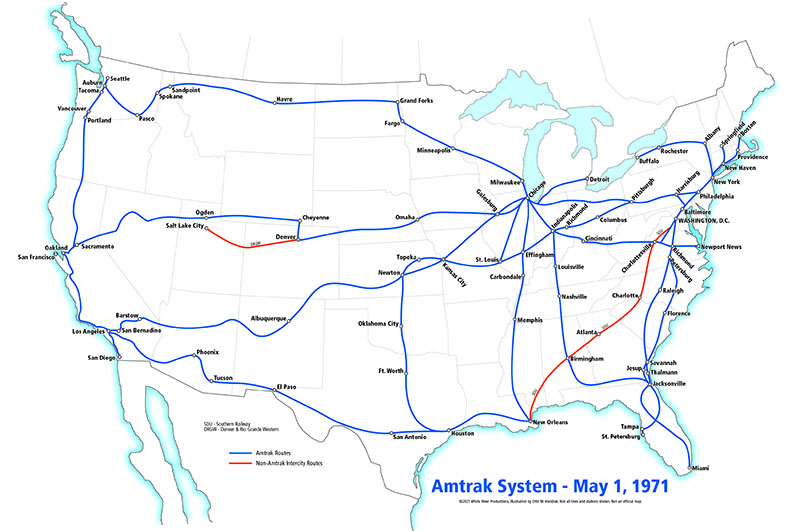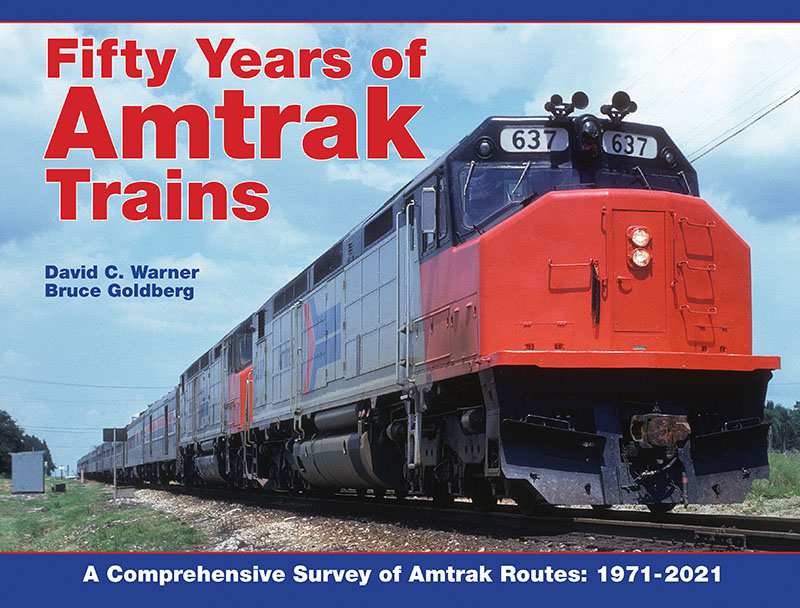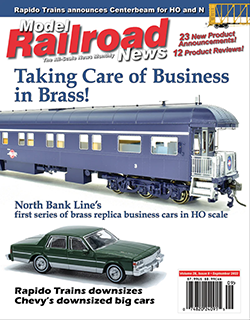By Justin Sobeck
If you want to know when the southbound Floridian called at Bloomington, Ind., or how the first Superliner equipment was tested… this new book, Fifty Years of Amtrak Trains, has it! This release is equally useful for modelers who have Amtrak services on their model railroads or a more than passing interest in how Amtrak operated through the years. Having been born 12 years into the Amtrak era and growing up on F40s and Amfleets on the state-funded Midwest routes, this book offers a just-right view into the half-century arc of “America’s Railroad,” as Amtrak is known. The authors were able to recount and record what they witnessed in the early Amtrak years, and through their own careers, stitching it all thoughtfully together with just the right blend of good photography and data. My own interest in pre-Amtrak passenger service and equipment stemmed from meeting a few private car owners on excursions out of St. Louis 20 years ago, and the realization that there was indeed more than Amtrak to this — which led to poring over an original edition and now dog-eared copy of Fred Frailey’s Twilight of the Great Trains (1998, Kalmbach Books). It was horrifically sad to understand how passenger service withered from a post-World War II bloom to the stalks that remain today under Amtrak, and this book illustrates that trajectory.

ABOVE: White River Productions’ Fifty Years of Amtrak Trains presents the expected system route map and much more. There are six U.S. maps (like the May, 1, 1971, example abovet) that take the reader through Amtrak service from its inception to 2021.
The decade-by-decade format that Warner and Goldberg present shows exactly how services and schedules by region changed over the course of the last 50 years; unfortunately, there has been more retreat than growth. A nicely written introduction, dedication, acknowledgments, and summary of what can be found guide you into a regional view of Amtrak’s operations, starting with the Northeast Corridor — the most densely traveled routes and infrastructure that Amtrak came to own through Penn Central and Conrail. The details of the motive power and equipment evolution on that part of Amtrak’s system is the most interesting to me — as the new generation of Siemens ACS-64 are drawing power from Pennsy’s ancient overhead catenary system while pulling Budd-built Amfleets that are roughly 45 years old. The Turbos and FL9s are well covered in the New York State chapter along with Delaware & Hudson PA-1s, and even the early international through service to Canada. Other New England services are discussed, and then the book focuses on eastern overnight and Florida service trains — P30CHs and EMD repowered RS-3s also make an appearance (even, surprisingly, later era Phase III livery).

ABOVE: This page showing Illinois service between Chicago and Carbondale is typical of what you’ll find for Amtrak trains in this new White River Productions book. The timetable-style information fills in the details of how services were operated over the years.
One note about the photos that are interspersed throughout is that they represent all eras — everything from E-unit 4316 in “Day One” attire to the newest 50th Anniversary scheme on P42 100 are featured, and serve to illustrate the various regional equipment and scenery where it operated. As far as presentation, the glossy finish to the area of the prints on the pages adds a richer texture and appearance to the book. Moving on geographically west, the East-Midwest routes are covered that either hubbed in or bypassed Chicago — and I harbor the opinion that we could once again use a National Limited/Inter-American run-through service connecting New York/Washington with Kansas City, and why not go on to Oklahoma or Texas? E-units from various owners/heritage and plenty of SDP40Fs can be found in this section, and an in-depth look at Indiana — a state whose rail mileage was decimated by Penn Central and Conrail, and even more recently CSX and Norfolk Southern operational changes. Michigan also got its own section, and The International service with VIA is covered — which reminded me of a sighting of a VIA F40PH with some Amtrak Superliners arriving at Chicago in July 1999, while I was departing on Amtrak train 59 The City of New Orleans back home to Carbondale, Ill. GP40FHs and 90200-series NPCU “Cabbage” cars are also shown throughout the Midwest and other states where they operated, as routes grew here briefly in support of the short-lived mail and express business.
The transition from steam-heated heritage equipment through to Head End Power or HEP-equipped Superliners is most apparent on the western, long-distance, overnight trains from Chicago and New Orleans to their Pacific destinations, as is the rationalization or slow trimming of routes and frequencies. On the West Coast, the growth of the current Los Angeles-San Diego (LOSSAN) corridor in support of Pacific Surfliners is shown through schedule progression, as well as emergence of the Capitol Corridor from San Jose/Oakland to Sacramento and down the Central and San Joaquin valleys. Amtrak’s testing and use of Talgo equipment is also covered in Washington and Oregon Department of Transportation-supported Cascades service. The answers to my questions posed in the first paragraph of this review are 3:15 in the morning at Bloomington, Ind., for train 52 starting in September 1975, and a Superliner test train shown at Tuscola, Ill., on November 20, 1976, on Illinois Central Gulf’s 90-mph Automatic Train Stop-equipped main line.
The appendix is full of additional information and supporting notes that help to round out the narratives in each section — including a list of train names and communities served by Amtrak. DuQuoin, Ill., became an Amtrak community with much fanfare on August 26, 1989, and yours truly was aboard train 392 that afternoon on my first day of kindergarten, along with then Illinois Governor James “Big Jim” Thompson — who detrained, made a speech, and then went to lead the annual DuQuoin State Fair parade. Lastly, notes on COVID-19 pandemic related service curtailments show how much flux the train service experienced. Authors David C. Warner and Bruce Goldberg have both spent time in the trenches at Amtrak, and this book offers probably the most comprehensive perspective of Amtrak’s services and schedules. It fits in nicely with their previous volume, The Metroliners (2016, White River Productions) — Budd and Pennsy’s first crack at dedicated high-speed equipment, as well as Warner’s collaboration with El Simon on Amtrak by the Numbers (2012, White River Productions) — a look at Amtrak’s equipment. Any student of Amtrak or American passenger equipment would be well served by having these titles in their library, as they complement each other with different perspectives and interests looking in on the last 50 years of passenger service.
White River Productions
shop.whiteriverproductions.com



 Enjoy the complete review in September 2022’s Model Railroad News!
Enjoy the complete review in September 2022’s Model Railroad News!